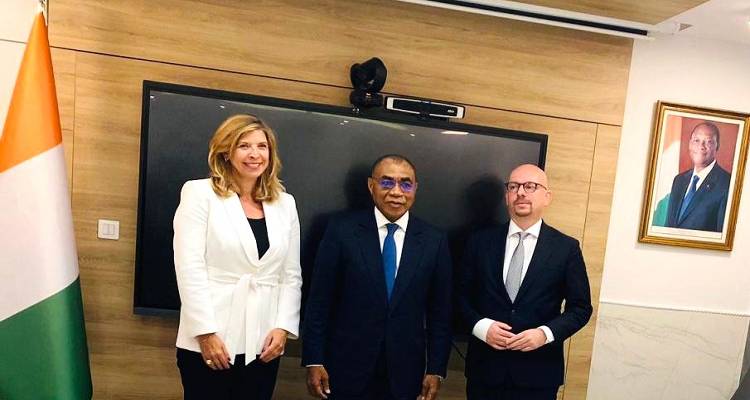The commercial connections between financiers, enterprises and emerging economies. Economic correspondent Moin Siddiqi reports
Inward foreign direct investment (FDI) flows to Africa during 2015 were estimated at between US$54-57.5bn, with some variance between sub-regions. According to The African Development Bank (AfDB), FDI in East Africa amounted to US$8.9bn since 2010; West Africa (US$9.7bn); Southern Africa (US$12.9bn); and Central Africa (US$5.4bn). The leading 2015 FDI destinations based on United Nations Conference on Trade and Development (UNCTAD) data were Angola (US$8.7bn); Mozambique (US$3.7bn); Ghana (US$3.2bn); Nigeria (US$3.1bn); Ethiopia (US$2.2bn); South Africa (US$1.8bn); Sudan (US$1.7bn); Congo, DRC (US$1.6bn); Zambia (US$1.6bn); Tanzania (US$1.5bn); Congo (US$1.4bn); and Kenya (US$1.4bn); respectively.
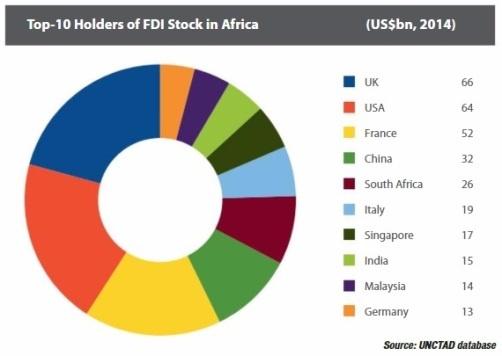
While advanced countries, notably the UK, the US and France, are important FDI providers, emerging economies, led by China, India, South Africa, United Arab Emirates (UAE) and Qatar are becoming a vital source too. Middle Eastern companies have invested an estimated US$100bn over the past decade.
Key sectors attracting FDIs are extractives, infrastructure (including real estate and construction), and consumer goods. However information and communications technology (ICT) has seen the highest proportion of new project startups. There is a trend towards services, manufacturing and special economic zones (SEZs), which can underpin the structural transformation of Africa. Electronic equipment, automotive and agribusiness comprise large chunks of manufacturing investments. Services-related FDI stock has also increased considerably in the past decade.
Multinational enterprises (MNEs) invest largely on the grounds of ‘market-seeking’ and ‘efficiency-seeking’ reasons (see footnote). For example, Ethiopia last year received US$2.2bn from Bangladeshi, Chinese and Turkish textile producers because of its privileged market access to North America and the European Union (EU) under the African Growth and Opportunity Act (AGOA) and Economic Partnership Agreements (footnote).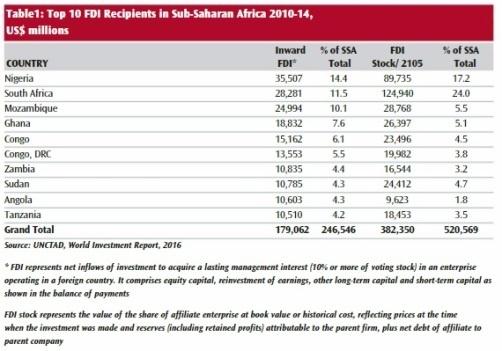
Increasingly diverse flows
Major commodity-exporting economies no longer attract the bulk of FDI, but several countries without significant resources are receiving sizeable inflows. Last year, the FDI-to-GDP ratio for non-resource rich countries stood at 4.4 per cent, compared to 2.5 per cent for resource-rich countries, according to UNCTAD figures. Kenya is becoming an East African business hub for manufacturing, intra-regional transport, services and ICT. Ethiopia’s FDI is mainly in labour intensive sectors. The 32 projects launched in 2015 had generated one-fifth of new jobs from FDI across Africa.
The ‘Herfindahl-Hirschman’ index, a measure of market concentration, indicates a shift to ICT, services, and manufacturing in Africa. The index dropped from 0.43 in 2003 to 0.14 in 2015. This trend is also confirmed by data on announced greenfield projects in 2015 from fDi intelligence, division of the Financial Times Group, which revealed that services and manufacturing comprised over half of the total value of African based projects. New investments are flowing into consumer-market oriented industries, chiefly telecom, retailing, food and financial services, driven by low wages, abundant natural resources and fiscal incentives provided by SEZs.
With rapid urbanisation, major African cities are becoming future hubs of investment (both domestic and foreign). Economic output and spending power in cities such as Cape Town, Johannesburg, Lagos, Luanda and Nairobi, among others, should surge in the coming decades. This, in turn, requires an improved business climate, infrastructure/ logistics services and availability of skilled workers.
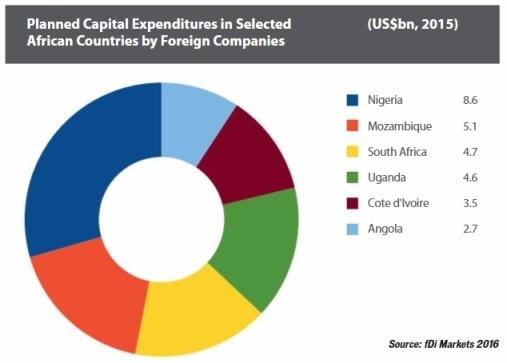 New reported FDI projects
New reported FDI projects
• Puma Energy (Singapore) opened one of the world’s biggest Conventional Buoy Mooring (CBM) systems in Luanda Bay (Angola);
• Major carmakers announced greenfield capex into the African auto-industry totalling US$3.1bn in 2015. They included Ford and Honda in Nigeria; Toyota in Kenya; BMW and Volkswagen in South Africa;
• The world’s two biggest beer producers (Heineken and Diageo) invested US$345mn and US$344mn, respectively, in Ethiopia;
• French telecom operator Orange bought the Democratic Republic of the Congo’s Millicom International Cellular’s operations (Tigo DRC) for US$160mn;
• Canada-based mining company Semafo is spending US$120mn to build a gold mine in Burkina Faso;
• Singapore’s agribusiness giant Olam acquired one of Nigeria’s largest millers, BUA Group, for US$275mn
Prospects
Overall, Africa’s perceived attractiveness has fallen over the past year. However, those already familiar with the continent remain relatively bullish.
Notwithstanding the bleak global and regional outlook, the International Monetary Fund (IMF) predicts 19 sub-Saharan African countries achieving real GDP growth of over 5 per cent during 2016-17.
Additionally, FDI inflows are expected to reach US$60-66bn this year, coupled with some privatisation of state-owned assets and proactive FDI legislation in the region.
The rise in FDI inflows will mostly occur in public utilities, transport and construction, followed by automotive industry and light manufacturing, such as food/beverages – reflecting growing consumer markets. Both Kenya and Tanzania now permit full foreign ownership of listed companies and Ethiopia has slowly liberalised its manufacturing and retail sectors. In sum, as competition for external risk capital heats up, the African countries need to improve their FDI regimes and increase infrastructure spending, especially on power-generation and transport networks to become more appealing to MNCs.
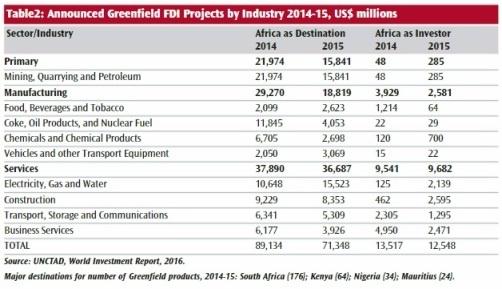
Footnote:
There are three types of FDI: Firstly, ‘MARKETSEEKING’ that involves replication of production facilities in the host country, targeted to serve local and regional markets.
The main criteria are market size, medium-term growth prospects, import tariffs and transport costs. Secondly, ‘ASSET-SEEKING’ (which is usually export oriented) and involves relocating production facilities to the host country.
Factor-cost such as availability of cheap labour and key raw materials [not available] in the home country are important considerations, particularly in the manufacturing industry. The output is mainly exported to the investor’s home market or other regions, hence asset-seeking or export-oriented FDI is unaffected by the host country’s market size.
Thirdly, ‘EFFICIENCY-SEEKING’, which aims to achieve greater economies of scale and scope, where investors are influenced largely by geographical proximity to their home country, thereby minimising transportation costs.
Economic Partnership Agreements (EPA) are ‘development-focused’ trade agreements negotiated between the African, Caribbean and African (ACP) countries/regions and the EU.
These partnerships are reciprocal, but asymmetric trade agreements, where the EU, as one regional block provides full duty-free and quota-free market access to EPA countries and/or regions and where ACP countries/regions, commit to open at least 75% of their markets to the EU.
This piece first appeared in African Review in October 2016











